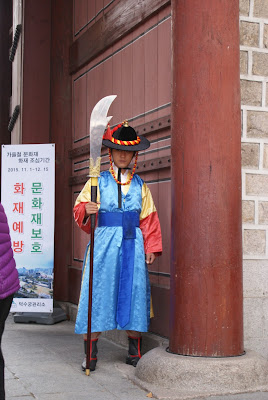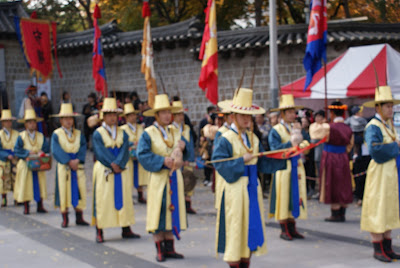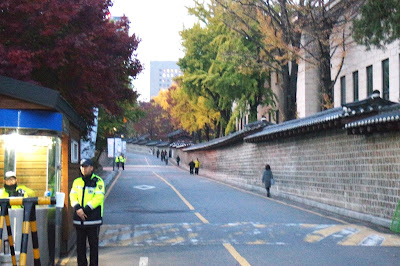The palace's operating hours are 09:00 - 21:00 (Ticketing 09:00 - 20:00) and it is closed on every Monday.
From Eungam Station, you can reach to this palace by bus 7022.
1. Daehanmun Gate and Geumcheon (waterway)
Upon entering Deoksugung Palace and Daehanmun, visitors will cross the waterway and wide bridge of Geumcheon. the waterway was intended to purify the minds of officials to ensure they worked for the king and the people honestly. The king's carriage would pass over this bridge during ancient times.
2. Gwangmyeongmun
Gwangmyeongmun was initially the front gate of the Emperor's sleeping chamber Hamnyeongjeon but it was moved to the current site and used as an exhibition hall. The bell of Heungcheon temple, a self striking water clock, and a muti-rocket launcher, which were made in late 14c and early 15c, are displayed.
3. Junghwamun and Junghwajeon
The Junghwamun is the main entrance to the main hall. As a basic architectural feature, every building has its own entrance and people can only enter the building through the gate. Now people can enter from any direction as the corridor surrounding the courtyards has been desroyed.
The Junghwajeon is a very stately throne hall, revealing its long history. The ceiling of the building and the emperor's exclusive pathway to it are adorned with dragon figures, and the window frames are golden. Almost all the servants' quarters around the throne hall were demolished after emperor Gojong's death.
4. Buildings
The Seokeodang is the only two-story building in the palace and it does not have the painting, Dancheong. King Seonjo moved to this building during the Japanese invation at the end of the 16th century. He was concerned about the hardships suffered by the people during the war, and ordered it to be left unpainted.
The Deokhongjeon Hall is on the the most recent building, built in 1911. Usually, Korean style buildings were built ina rectangular shape, but this is almost square. On the ceiling, there is a light which was first installed at Gyeongbokgung Palace in 1887.
The Jeonggwanheon, which means 'place from which to watch the garden silently', was built in 1900, and was the first example of European architecture ever built in a royal palace.
The Junmyeongdang was a palce which king met a foreign envoys.The Jeukjodang is a building which Gwanghaegun and In-Jo ascended to the throne here. The two building is connected with a corridor.
5. Seokjojeon
Seokjojeon is the other western-style building that still remains in Deoksugung, and it was built by a British man. After the Korean Declaration of Independence, the American-Russian joint commission was held here as well in May 1946. The east wing of Seokjogwan building now serves as a palace treasure exhibition, and the west wing is used as part of the National Modern Art Center.
Reservation may be needed (For foreigner, every time 5 person can be allowed to enter without reservation).
6. The Royal Guards Changing Ceremony
The elite Palace Guards calld Geum-gun defended the palace gates and escorted the king. The Geum-gun was resposible for opening and closing the palace gates as will as guarding and patrolling the area around the gate. Currently the changing of guards ceremony is performed at the Dahanmun Gate at everyday 11:00, 14:00, and 15:30 (except for Monday).
7. Nearby Deoksugung Palace
a. Pathway along the palace wall
The pathway along the palace is famous for lovers as it is beautiful. But it is said that the lovers may be broken up with each other if they walk through the road.
b. Seoul City Hall
c. Chung-dong First Methodist Church
Chung-dong First Methodist Church is the birthplace of Korean protestantism.
d. Anglican Church
The church building has been used with uncompleteness after started to build in 1922. As the original design drawing by Arthur Dickson was found, the builing was completed in 1996.






















































































댓글 없음:
댓글 쓰기